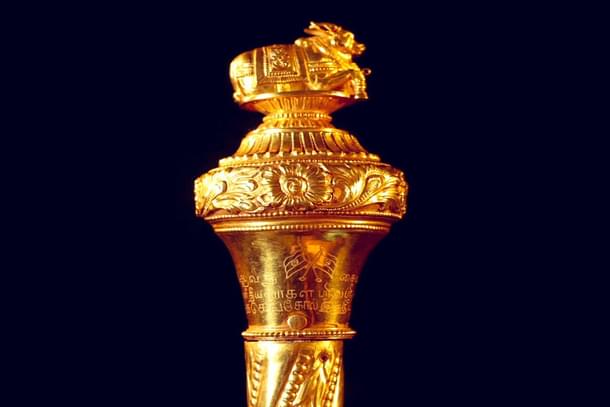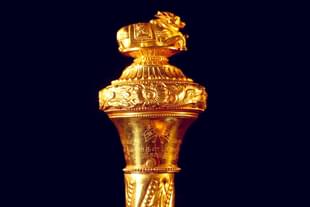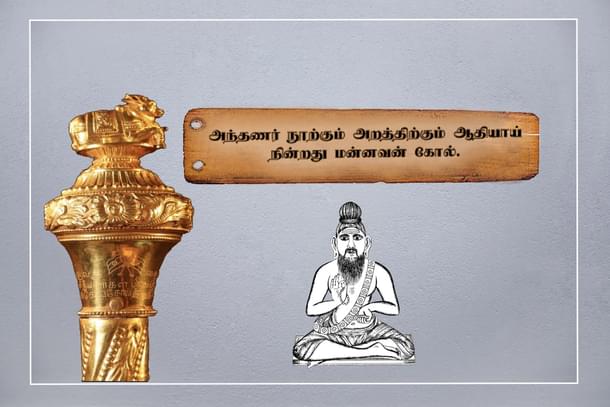Politics
Sengol: Not Symbol Of Power But Dharma Over Power
Aravindan Neelakandan
May 25, 2023, 12:50 PM | Updated 12:50 PM IST
Save & read from anywhere!
Bookmark stories for easy access on any device or the Swarajya app.


Today the entire nation speaks about the 'Sengol'. Crudely and only for the sake of convenience, it is translated into 'sceptre'.
But worse, it was labelled as 'the golden walking stick given to Nehru.'
One only wishes Nehru used it to walk the path of what it symbolised.
But what does a 'Sengol' actually symbolise?
It symbolizes that Dharma reigns over the temporal power. The purpose of Sengol is to protect Dharma and Truth.
The great Tamil sage Thiruvalluvar states this very clearly in his Thirukkural. He has dedicated an entire chapter for what he calls Senkonmai which means it is the Sengol defines good governance.
The great revolutionary colleague of Veer Savarkar, VVS Iyer has translated the entire Kural into English and he calls this chapter 'Just Government'. In the third of the ten couplets or kurals under this chapter, Thiruvalluvar says the following :

The sceptre of the prince is the mainstay of the science of the Brahmans and of righteousness also. (Kural 543: VVS Iyer)
The sceptre of the king is the firm support of the Vedas of the Brahmin, and of all virtues therein described. (Kural 543: GU Pope)
Thirukkural also has a traditional commentary, that of Parimelazhakar. In his commentary on this particular kural he states:
... Though Vedas and Dharma are primordial anadhi, Sengol is needed for them being present (in the society) and hence (Thiruvalluvar) called the Sengol as Aadhi (with respect to Vedas and Dharma which are Anadhi).
It is quite surprising that the wise interpreters of the preamble of the Constitution of India also came to a very similar conclusion:
The pledge of the people of United States has been to establish justice, whereas that of the Indian people has been to secure justice. To establish is to set up; but to secure is to make safe or to firmly fix. ...the people of India have recognised and taken for granted the virtue of justice as a primordial reality, and have willed their Constitution to conform to it; but the people of the United States have taken justice as an emergent property of their Constitution and have wished justice to conform to their Constitution. In India, the Constitution is a creature of justice; but in America justice appears to be a creation of Constitution.R G Chaturvedi, State and Rights of Men, 1971, p.199 quoted in Prof. Arvind Sharma, 1997
So what is this Dharma? And does it mean that a religious belief is above the secular institutions of State?
Dharma is not theocracy or dogma of any kind. The Brihadaranyaka Upanishad explains the following as the core of Dharma:
Yet the Divine did not flourish. The Divine specially projected that excellent form, Dharma. This Dharma is the controller of the ruler. Therefore there is nothing higher than that. So even a weak person hopes to defeat a stronger man through Dharma, as (one contending) with the king. That Dharma is verily truth. Therefore they say about a person speaking of truth, 'He speaks Dharmic,' or about a person speaking Dharma, 'He speaks .of truth,' for both these are but Dharma.Brihadaranyaka Upanishad I.4.14
Dharma is that which makes the powerless powerful through justice, and truth. It is at once a humanistic principle and also an impersonal cosmic harmony.
In other words Dharma is eternal but it has to manifest itself in the human society prone to social entropy and the power of the ruler is created only to facilitate this Dharma in society.
It is this core principle of the Brihadaranyaka Upanishad that we see echoing in the commentary of Parmelazhar on Thirukkural.
The bull at the top of the Sengol is the bull of Dharma. In the sacred literature of India, Dharma is always symbolised as a bull. It is also the all-pervading form of Vishnu. In Buddhist literature, Buddha is often called the bull.
Thus the Sengol represents at once the timeless Rta and the justice and truth of the constitutional social realm.
By restoring the Dharma Sengol to its place of honour in the Parliament, the Government of India under the prime ministership of Narendra Modi and the presidency of Droupadi Murmu, has redeclared its civilizational grandeur and commitment.
Aravindan is a contributing editor at Swarajya.





